The Rise of No-Code AI Tools: Empowering Developers
The Rise of No-Code AI Tools: Empowering Developers in 2025
Key Takeaways
No-code AI tools are redefining how developers and business users build intelligent applications—breaking down technical barriers and accelerating innovation in 2025. These platforms empower teams to deliver smarter solutions faster while opening new career pathways and strengthening collaboration.
- No-code AI democratizes development by letting business users and citizen developers create AI-driven apps with drag-and-drop interfaces, drag and drop interface, and pre-built components, slash development cycles from months to days.
- No-code AI tools allow users to build intelligent applications without writing code, making AI accessible to a wider audience.
- Key features to look for in no-code AI platforms include a drag and drop interface, pre-built components, and automated workflows, which make building AI solutions easier for non-technical users.
- The no-code/low-code market is booming, projected to surpass $187 billion by 2025, driven by urgent digital transformation needs and persistent talent shortages in AI and engineering.
- Developers shift focus from routine coding to high-impact work like custom AI model training, backend optimization, and security governance, collaborating closely with citizen developers to boost delivery speed and quality.
- AI-powered no-code platforms enhance productivity through features like real-time code suggestions, automated testing, and performance optimization, minimizing bugs and speeding releases.
- Startups and SMBs gain a competitive edge by using no-code AI tools to launch sophisticated AI features affordably, leveraging AI to automate processes and gain insights without technical barriers, leveling the playing field with larger enterprises without heavy upfront costs.
- Successful no-code AI adoption demands strategic integration and governance—prioritizing platform alignment, secure data management, and continuous monitoring to avoid scalability and compliance pitfalls.
- Mastering no-code AI platforms like Bubble and Power Automate unlocks faster prototyping, automation, and cross-team innovation, boosting developer creativity and business impact.
- Looking ahead, developers must embrace no-code AI as a partner by honing skills in AI customization, security, and collaboration to lead agile, cross-disciplinary teams shaping digital transformation.
Dive into the full article to explore how no-code AI tools turbocharge development workflows, expand career opportunities, and power smarter innovation for businesses ready to scale boldly in 2025.
Introduction
Imagine launching an AI-powered app in days—no complex coding, no coding skills required, no waiting weeks for developer resources. That’s the power no-code AI tools are bringing to startups and SMBs in 2025.
The market for no-code and low-code platforms is skyrocketing, projected to hit $187 billion this year.
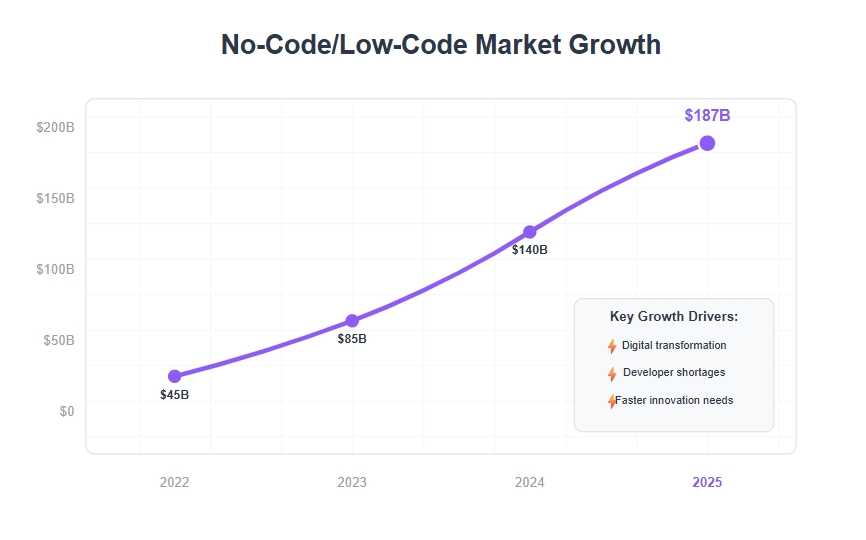
This explosion is fueled by urgent digital transformation needs, developer shortages, and the push for faster innovation without sacrificing quality.
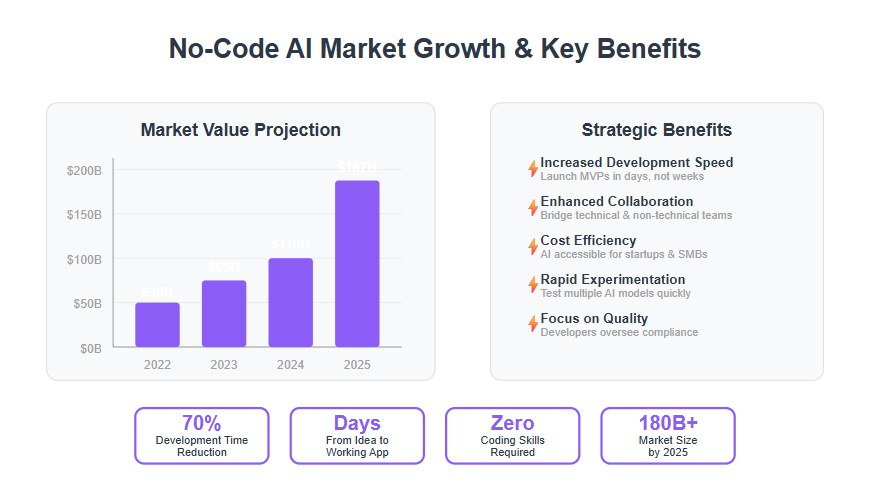
For busy teams juggling tight budgets and big ambitions, no-code AI is opening doors to:
- Rapid prototyping and deployment
- Greater collaboration between technical and non-technical roles
- Access to sophisticated AI features without a deep coding background
- The ability to quickly create working applications using no-code AI tools
Whether you’re a developer ready to boost productivity or a business leader eager to accelerate growth, these tools reshape how solutions get built—fast, flexible, and scalable.
The rise of “citizen developers” who combine domain knowledge with intuitive AI platforms is redefining innovation cycles and breaking down traditional bottlenecks.
A no code environment now enables seamless collaboration and rapid development, allowing teams to prepare data, build machine learning models, and visualize results—all without programming expertise.
This shift doesn’t sideline developers—it amplifies their impact by freeing them from repetitive tasks and empowering them to focus on custom integrations, security, and advanced AI modeling.
Ahead, we’ll explore how no-code AI tools are transforming development workflows, unlocking new career paths, and driving real-world results across industries.
Keep reading to discover how embracing this evolution can give your team the agility and confidence to build smarter products in today’s fast-paced market.
The No-Code AI Revolution: Foundations and Market Landscape in 2025
No-code AI tools are transforming how businesses build and deploy AI-driven applications, letting users create solutions without writing traditional code. Previously, software developers were required to build these solutions, but now no-code platforms reduce dependency on traditional programming skills.
These platforms democratize advanced technology access, making code artificial intelligence platforms accessible to non-technical users and putting AI capabilities into the hands of marketers, business owners, and citizen developers—folks who know the problem but aren’t coders.
With no-code AI tools, the development process is streamlined and more agile, enabling a wider range of users to efficiently create and manage AI solutions.
Surge in Adoption and Market Growth
The no-code and low-code market is booming, projected to hit $187 billion by 2025.
Key drivers include:
- The urgent need for rapid digital transformation
- Talent shortages in AI and software engineering
- Growing appetite for agile, user-friendly tools that cut development time
Retail, financial institutions, finance, healthcare, and marketing sectors lead adoption, using no-code AI for everything from personalized customer experiences to fraud detection and automated diagnostics. In retail, analyzing historical data helps forecast demand and optimize inventory, while financial institutions leverage no-code AI to streamline processes like customer onboarding, credit risk assessment, and fraud detection.
How No-Code AI Empowers Users
Think of no-code AI platforms like a modular toolkit:
- Drag-and-drop interfaces and drag and drop functionality enable rapid prototyping, slashing time from idea to MVP
- Pre-built AI components mean non-technical users can solve real business problems without waiting on IT
- Pre built templates enable users to quickly launch applications with ready-made solutions
- Iterations happen fast, allowing innovation cycles to keep pace with changing market needs
This shift ramps up business agility and slashes dependency on scarce developer resources.
Enter the Citizen Developer
A rising force in 2025, citizen developers are business professionals empowered with no-code AI to create apps, workflows, and automations.
They break free from traditional IT bottlenecks and bring domain expertise directly into product development, speeding innovation across teams. With no-code AI platforms, non-technical teams can now actively participate in AI projects, fostering collaboration between technical and non-technical teams for more efficient deployment.
No-Code AI’s Place in Broader Strategy
No-code AI tools aren’t just convenient—they’re foundational to AI-first and digital transformation strategies.
They enable companies to dive into AI-powered opportunities with lower risk and cost, evolving from experimentation to enterprise-grade solutions faster than ever.
Picture this: a marketing manager builds a tailored customer segmentation app using no-code AI during a coffee break—no developer needed, no months of waiting. That’s the new normal.
Key takeaways:
- No-code AI is unlocking AI creation for business users at scale
- The market will surge beyond $180B as adoption widens across industries
- Citizen developers are reshaping innovation by combining domain know-how with AI power
Adopting no-code AI as part of a digital transformation strategy offers key benefits, such as making cloud integration and cloud-based application development more accessible through drag-and-drop interfaces, empowering non-developers to leverage cloud computing with ease.
This revolution is redefining who gets to build software—and how fast they do it.
Empowering Developers: How No-Code AI Tools Transform Roles and Workflows
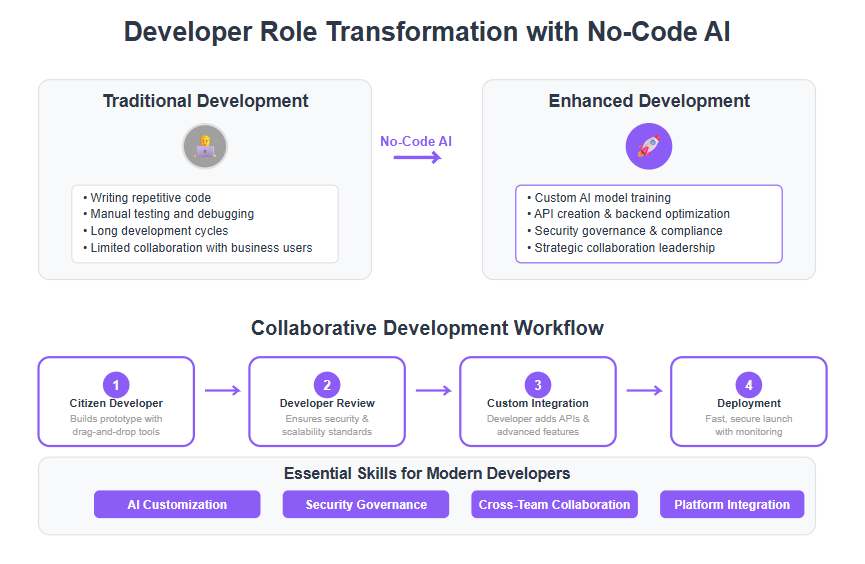
Shifting Developer Focus: From Routine to Specialized Tasks
No-code AI tools free developers from repetitive coding, letting them concentrate on higher-impact work like API creation, backend optimization, and custom AI model training.
This shift empowers developers to tackle challenges that no-code platforms can’t solve, adding real technical depth to projects.
Developers now partner closely with citizen developers—business-savvy users building their own solutions—to speed up delivery while ensuring quality and security.
Roles centered on integration, scalability, and governance oversight become crucial as no-code adoption grows across industries.
- Focus areas for developers include:
- Advanced backend logic
- AI model customization
- Monitoring platform security and compliance
This partnership accelerates innovation cycles: imagine a developer tuning APIs while a marketer spins up AI-driven campaigns in parallel.
AI-Enhanced Development Environments
Today's no-code AI platforms include intelligent assistants that offer:
- Real-time code suggestions
- Automated testing
- Performance optimization
These features drive productivity gains and help release higher-quality apps faster.
For example, AI-powered error detection can catch bugs early, reducing costly downstream fixes.
Developers and business users alike benefit from this frictionless workflow, shortening product iterations and lightening cognitive load.
Think of it like having a smart co-pilot who spots issues and suggests improvements before you even notice.
Emerging Career Paths and Skills for the No-Code Era
As no-code AI tools take center stage, new roles emerge, such as:
- No-Code Solution Architects designing integrated workflows
- AI Integration Specialists tailoring AI models to specific business needs
To stay ahead, developers should sharpen skills in:
- Cross-functional collaboration with citizen developers
- Customizing and fine-tuning AI models
- Governance, security, and compliance best practices
Mastering these tools unlocks career transformation: developers become strategic partners rather than just coders.
This era favors those who embrace adaptability and lifelong learning while balancing creativity with technical rigor.
No-code AI isn’t sidelining developers—it’s amplifying their impact and opening doors to new opportunities.
No-code AI shifts developers away from rote tasks toward specialized, high-value roles focused on integration, security, and innovation. AI-enhanced platforms streamline workflows while opening career paths for those who collaborate across disciplines and harness new AI capabilities. This transformation invites developers to lead the next wave of digital innovation.
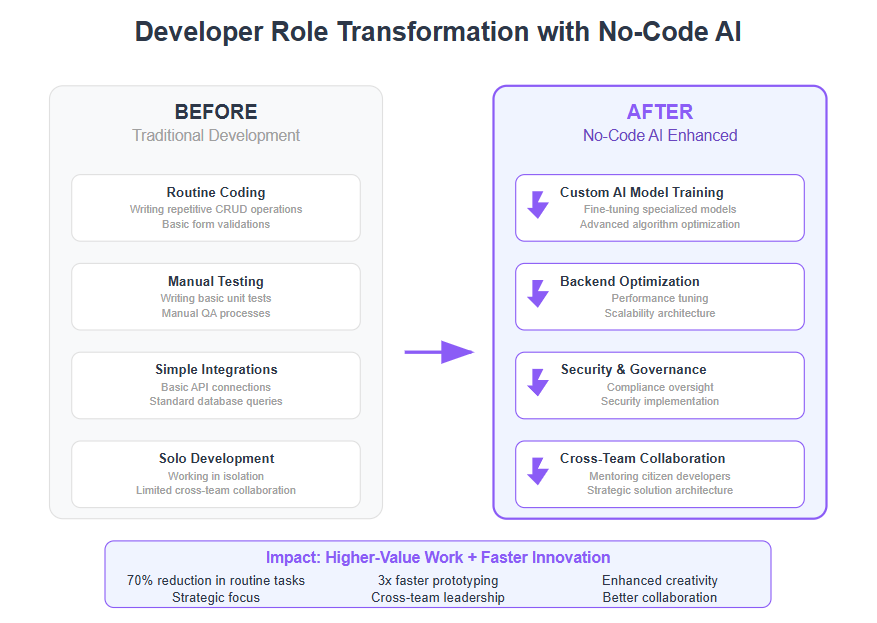
Unlocking Innovation: Strategic Benefits and Practical Impact of No-Code AI for Developers
No-code AI tools are accelerating innovation by letting developers build and iterate faster than ever before. These platforms enable the creation of automated workflows and AI solutions, streamlining the development process and making it easier to deploy intelligent applications without extensive coding. By cutting down the time spent on routine coding, teams can focus on strategic, high-impact challenges that push projects forward.
Seven Strategic Benefits of No-Code AI
- Increased development speed helps launch MVPs and prototypes in days, not weeks.
- Greater flexibility lets developers pivot and customize workflows on the fly.
- Enhanced creativity emerges as technical barriers drop, encouraging experimentation, especially with the support of customizable templates and design tools that enable rapid prototyping and easy iteration.
- Improved collaboration between developers and citizen developers drives faster delivery.
- Cost efficiency makes AI integration accessible even for startups and SMBs with limited budgets.
- Scalability awareness ensures rapid growth doesn’t break your systems.
- Focus on quality and security empowers developers to oversee compliance without slowing innovation.
Rapid Experimentation Powers Market Fit
No-code AI platforms create a safe space for quick testing. Picture a startup trying three different recommender system models in a week, using generative ai to quickly generate new features without needing programming expertise, and all without writing a single line of code. This kind of rapid iteration allows organizations to respond instantly to market feedback and refine products in real time.
This iterative cycle is a game-changer for getting features right faster — freeing developers to move from firefighting bugs to crafting better solutions.
Levelling the Playing Field for Startups and SMBs
For smaller players, no-code AI reduces technical debt and upfront costs. Small business owners can leverage AI to automate marketing activities, such as social media management, and streamline operations, helping them save time and focus on growth. Instead of hiring large dev teams, SMBs can use these tools to access sophisticated AI-driven features usually reserved for big enterprises.
- This levels the playing field by allowing startups to launch smarter products quickly.
- It also enables SMBs to experiment with AI-powered marketing, finance automation, and customer support without heavy investments.
Balancing Innovation with Technical Rigor
While no-code AI opens doors, developers must still enforce security standards, governance policies, and customization limits—especially in regulated industries like healthcare and finance. Addressing security concerns is crucial when implementing no-code AI solutions, as organizations need to mitigate risks and establish clear policies to prevent vulnerabilities from unauthorized or insecure application development.
Adopting a hybrid approach—leveraging no-code for speed while applying traditional coding for critical backends—ensures innovation never sacrifices robustness.
Think of it like driving a sports car with cruise control on highways and manual steering through tricky curves.
No-code AI isn’t about replacing developers; it’s about enabling you to build smarter, faster, and with more creative freedom while keeping the wheel firmly in your hands.
Unlocking these benefits means you’re not just keeping pace—you’re setting the pace for how software development evolves in 2025 and beyond.
Implementing No-Code AI Tools: Best Practices for Developer Success
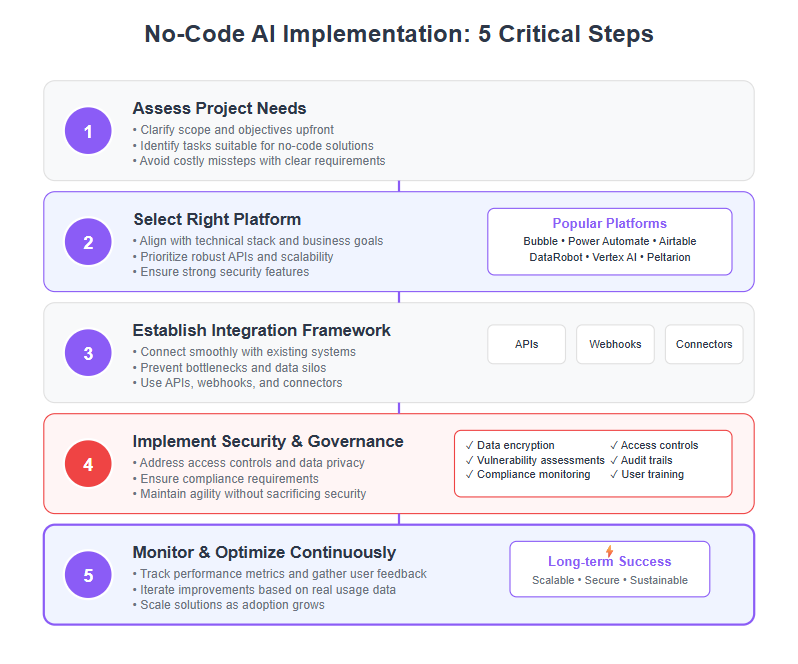
Five Critical Steps for Seamless No-Code AI Integration
Before jumping into no-code AI adoption, it’s essential to assess your project’s needs. Not every task suits no-code tools, so clarify scope and objectives upfront to avoid costly missteps.
Next, carefully select no-code AI platforms that align with both your technical stack and business goals. Look for tools offering robust APIs, scalability, and security features.
Establishing a solid integration framework is key. Connect no-code solutions smoothly with existing systems and data sources to prevent bottlenecks or data silos.
Don’t overlook governance and security protocols tailored for no-code environments. These must address access controls, data privacy, and compliance requirements without stifling agility.
Finally, put in place processes for continuous monitoring and optimization. Track performance metrics and user feedback to iteratively improve your no-code AI applications.
Quick takeaways:
- Match no-code AI use cases closely with project needs
- Prioritize integration and security frameworks early on
- Monitor actively for long-term success
Overcoming Common Challenges
No-code AI isn’t a silver bullet — scalability and customization can hit limits as projects grow more complex. Plan for when shifting to hybrid solutions or traditional coding makes sense.
Security is another hot spot. Because no-code tools often operate in cloud environments, maintaining robust cybersecurity requires:
- Continuous vulnerability assessments
- Strict user access controls
- Encryption of sensitive data
Managing citizen developers—business users building apps—is critical to maintain quality. Establish clear standards and governance policies to avoid:
- Fragmented codebases
- Compliance risks
- Inconsistent user experiences
No-code AI platforms also reduce the need for hiring data scientists and eliminate the barrier of requiring extensive coding expertise, making advanced solutions accessible to a broader range of users.
Pro tip: Empower developers to act as mentors and quality gatekeepers, blending innovation with discipline.
Imagine onboarding a no-code platform that lets your sales team build AI-powered dashboards, while your devs focus on custom APIs and security layers. This balance turbocharges delivery without burning out anyone.
Wrap-Up
Implementing no-code AI tools means combining smart platform selection, strong integration, and clear governance. Keeping an eye on growth limits and security turns no-code from a neat experiment into a strategic advantage. With the right approach, you’ll unlock faster innovation cycles and empower your whole team to build boldly.
AI Integration and Models: Bridging No-Code and Advanced AI Capabilities
The integration of AI with no-code platforms is transforming the landscape of app development and automation, making advanced AI accessible to a broader audience than ever before. No-code AI platforms empower non-technical users to build complex applications using intuitive visual interfaces and pre-built components, eliminating the need for extensive coding knowledge. This new wave of no-code tools is enabling organizations to rapidly develop, deploy, and scale intelligent solutions that once required specialized programming expertise.
Let’s explore how no-code platforms seamlessly connect with existing systems, the variety of AI models available, and why scalability and security are essential for successful AI integration.
How No-Code Platforms Integrate with Existing Systems
No-code platforms are designed to fit effortlessly into your current technology ecosystem. Through APIs, webhooks, and a wide array of integration methods, no-code AI platforms allow non-technical users to connect their applications to popular data sources, cloud services, and legacy systems—without writing a single line of code. This means businesses can leverage their existing infrastructure while unlocking the speed and flexibility of no-code development.
For example, a financial institution might use a no-code platform to build a custom dashboard that pulls real-time data from their CRM, automates client onboarding, and streamlines customer engagement—all within a unified interface. Leading no-code AI platforms like Bubble offer pre-built connectors for widely used services such as Salesforce, Google Drive, and Slack, enabling seamless data flow and process automation. By enabling non-technical users to integrate AI into their workflows, no-code platforms are breaking down barriers and accelerating digital transformation across industries.
Types of AI Models Available in No-Code Tools
No-code AI tools come packed with a diverse set of AI models, making it easy for users to add intelligence to their applications. Whether you’re looking to automate data analysis, enhance customer service, or generate content, no-code platforms offer pre-built machine learning models, natural language processing (NLP) modules, and computer vision capabilities—all accessible through simple drag-and-drop interfaces.
For instance, a no-code AI platform like DataRobot provides ready-to-use machine learning models for predicting customer churn or sales trends, while platforms like Peltarion offer NLP models for tasks such as text classification and sentiment analysis. These code tools allow non-technical users to build AI-powered applications—like chatbots, recommendation engines, or automated content generators—without needing extensive programming knowledge or data science expertise. The result: organizations can quickly deploy functional, intelligent solutions that drive real business value.
Ensuring Scalability and Security in AI Integrations
As organizations increasingly rely on no-code AI platforms to integrate AI into their business processes, ensuring scalability and security becomes paramount. Modern no-code platforms are built on robust, cloud-based infrastructure that automatically scales to handle growing workloads, so your applications remain responsive as usage increases. Leading code ai platforms like Google Vertex AI offer built-in features for automated scaling, performance monitoring, and security, allowing teams to focus on innovation rather than infrastructure management.
Security is equally critical. No-code platforms typically provide enterprise-grade features such as data encryption, granular access controls, and detailed auditing to protect sensitive information and ensure compliance with industry regulations. By prioritizing these safeguards, businesses can confidently integrate AI into their workflows, knowing their data and processes are secure. Ultimately, scalable and secure no-code AI integrations significantly enhance business processes, streamline customer engagement, and empower organizations to innovate at speed—without compromising on reliability or trust.
Mastering No-Code AI Tools: Essential Platforms and Workflow Enhancements for Developers
By 2025, mastering no-code AI platforms is a must for developers aiming to stay ahead. Tools like Bubble, Microsoft Power Automate, and Airtable’s AI integrations top the list, offering intuitive interfaces to build sophisticated AI-driven applications without writing traditional code, including deploying AI driven chatbots for customer engagement.
Streamlining Workflows and Automating Repetitive Tasks
These platforms help developers:
- Automate data processing and routine workflows faster than manual coding
- Build prototypes in hours instead of weeks, speeding up feedback cycles
- Leverage built-in AI models for tasks like natural language processing and image recognition
Picture this: a developer using a drag-and-drop builder to integrate sentiment analysis into customer feedback, cutting development time by 70%. That’s not just convenience—it’s a serious productivity boost.
Real-World Use Cases That Amplify Productivity
Consider an SMB marketing team deploying automated campaign analytics via no-code AI tools. The developer’s role shifts from coding algorithms to customizing integrations, ensuring data flows securely and scales smoothly.
Other examples include:
Retailers using AI chatbots built on no-code platforms to enhance customer support instantly.
Finance startups automating fraud detection workflows without heavy backend development.
Healthcare providers speeding up appointment scheduling with AI-powered no-code apps.
Creators leveraging no-code AI tools for automated video editing and content creation, streamlining the editing process and enhancing creative workflows.
These cases show how developers free themselves from grunt work to focus on creative problem-solving and innovation.
Unlocking Developer Creativity and Innovation
Mastering no-code AI tools opens doors to:
- Rapid experimentation with new features and AI capabilities
- Enhanced cross-team collaboration between developers and citizen developers
- Building complex solutions faster, yet with improved flexibility and control
Here’s a nugget worth sharing: “No-code AI isn’t about replacing developers—it’s about amplifying their impact.”
Developers who embrace these platforms become agile innovators who deliver value rapidly and confidently in evolving markets.
Staying fluent in no-code AI tooling isn't just trendy—it’s a strategic career move that empowers developers to solve bigger problems with less friction, accelerating both personal growth and business success.
Looking Ahead: The Future of No-Code AI and Developer Collaboration
The no-code AI market is set to surpass $187 billion by 2025, with its impact only growing deeper in speed, flexibility, and inclusivity.
Expect platforms not just to simplify AI use but to generate complex code snippets automatically and offer seamless, multi-system integrations.
Advanced Tech on the Horizon
Here’s what’s coming next in no-code AI tools:
- AI-generated code enhancements that produce cleaner scripts with minimal human input
- Deeper API and data integrations connecting more legacy and cloud systems
- Real-time collaboration features blending human and AI creativity
Imagine a developer and a citizen coder working side-by-side in a unified environment, each contributing their strengths without code holding them back.
Culture Shift: Blurring Lines Between Roles
The future workspace favors a blend of skills:
- Agile, cross-disciplinary teams where developers and business users build solutions together
- Developers shifting from solo coders to collaborative solution architects guiding no-code projects
- Citizen developers empowered to innovate rapidly, supported by tech experts
This approach accelerates innovation cycles and breaks down traditional bottlenecks.
Why Developers Should Embrace No-Code AI Now
Want to stay ahead? Focus on these three actions:
Master AI integration and customization to add value beyond default tools
Develop skills in governance and security to ensure robust no-code solutions
Treat no-code AI as a partner, not a replacement, for your technical expertise
Think of no-code AI like a turbo boost—it can free you from the mundane and elevate your role to strategic problem-solver.
Picture This
You’re leading a team where a marketer quickly prototypes an AI-powered campaign tool through drag-and-drop, while you ensure it scales securely across systems. Fast, flexible, and built for impact.
No-code AI isn’t the future; it’s today’s launchpad to smarter development and stronger collaboration.
This growth demands that developers adapt, leveraging no-code’s speed and inclusivity to fuel career growth and deliver deeper organizational impact. The key: blend human creativity with AI efficiency to create solutions that no one could build alone.
Mastering this balance will keep you indispensable in a world where everyone’s building smarter—and faster.
Conclusion
No-code AI tools are reshaping how developers and business users collaborate, unlocking faster innovation and deeper impact across industries. By automating routine tasks and empowering citizen developers, these platforms free you to focus on strategic challenges—amplifying your role as a creative problem solver and technical leader.
To make the most of this shift, embrace the partnership between no-code AI and traditional development. Harness AI-powered workflows, prioritize security, and foster cross-functional collaboration to transform ideas into scalable solutions with speed and agility.
Here are key actions to accelerate your journey:
- Explore no-code AI platforms that integrate seamlessly with your existing stack
- Develop skills in AI customization, governance, and security to maintain control and compliance
- Collaborate actively with citizen developers to leverage domain knowledge and speed delivery
- Plan for hybrid workflows that balance no-code rapidity with traditional coding precision
- Continuously monitor and optimize no-code implementations for performance and scalability
Start by identifying a project where you can pilot a no-code AI solution this week—something that offloads repetitive work and creates space for innovation.
Remember, the future isn’t about developers or no-code tools alone—it’s about the powerful combination of both. When you blend human creativity with AI efficiency, you become unstoppable in building smarter, faster, and more impactful products.
No-code AI is your turbo boost—accelerate fiercely, keep the wheel in your hands, and lead the next wave of digital innovation.
